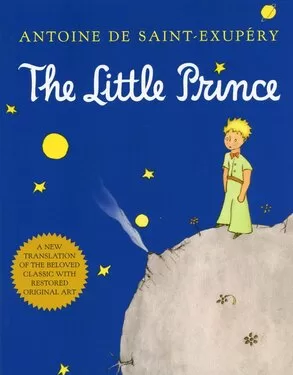Antoine de Saint-Exupéry -2000

In Antoine de Saint-Exupéry’s beloved masterpiece, ‘The Little Prince,’ lies a trove of magic and wisdom that continues to thrill readers of all ages. This timeless classic takes us on a journey through the whimsical imagination of a young prince who embarks on an adventure across the universe. From encounters with peculiar characters on different planets to thought-provoking conversations about life and love, the story unravels profound insights that resonate with readers on a deeper level.
With its simple yet profound storytelling, ‘The Little Prince’ offers a unique perspective on the human experience, addressing universal themes such as friendship, creativity, and the pursuit of happiness. It reminds us of cherishing our inner child, embracing our curiosity, and seeking meaning in the simplest things.
As we uncover the magic and wisdom within ‘The Little Prince,’ we are reminded that the most significant lessons in life are often found in the pages of a treasured book. So, join us as we delve into this literary gem’s enchanting world and rediscover its timeless wisdom.
The life and inspiration of Antoine de Saint-Exupéry
At the heart of the timeless classic, “The Little Prince,” lies the remarkable life and experiences of its author, Antoine de Saint-Exupéry. Born in 1900 in Lyon, France, Saint-Exupéry was a man of many talents – a pioneering aviator, a celebrated writer, and a visionary thinker who left an indelible mark on the world.
Saint-Exupéry’s life was a tapestry of adventure, introspection, and a deep connection with the natural world. As a young man, he pursued his passion for aviation, becoming a pilot and later a mail courier, navigating the skies over North Africa and South America. During these long flights, often alone in the cockpit, he developed a profound appreciation for the beauty and fragility of our planet, an inspiration that would later manifest in the pages of “The Little Prince.”
Beyond his aviation career, Saint-Exupéry was also a gifted writer, penning a series of acclaimed works that explored themes of human relationships, the search for meaning, and the importance of preserving our connection with the natural world. It was this rich tapestry of experiences and insights that ultimately gave birth to the timeless tale of “The Little Prince,” a story that has captivated readers for generations and continues to inspire new generations of dreamers and philosophers.
Key themes and messages in “The Little Prince”
At the heart of “The Little Prince” lies a tapestry of profound themes and messages that resonate with readers of all ages. From the importance of cultivating meaningful relationships to the search for true happiness, the book’s enduring appeal lies in its ability to speak to the universal experiences of the human condition.
One of the central themes in “The Little Prince” is the power of love and friendship. Through the protagonist’s interactions with the various characters he encounters on his journey, the reader is reminded of the transformative nature of genuine connection and the importance of cherishing those we hold dear. The book’s poignant exploration of the Little Prince’s relationship with his beloved rose, for instance, serves as a powerful metaphor for the complexities and fragility of love.
Another key theme in the story is the pursuit of happiness and the recognition that true fulfillment often lies in life’s simple pleasures. The Little Prince’s encounters with the eccentric inhabitants of the various planets he visits serve as a commentary on the human tendency to become consumed by ego, materialism, and a disconnection from the natural world. The book’s message encourages readers to embrace their inner child, cultivate a sense of wonder and curiosity, and find joy in the most ordinary of things.
Analysis of the main characters in the book
At the heart of “The Little Prince” is a cast of unforgettable characters, each of whom serves as a vessel for the book’s profound themes and messages. From the titular protagonist to the enigmatic narrator, the characters in this timeless tale come to life with a depth and complexity that continues to captivate readers.
The Little Prince himself is a true embodiment of innocence, curiosity, and a deep connection with the natural world. As he navigates the various planets he encounters, the reader is drawn into his whimsical perspective, which challenges the often jaded and cynical worldviews of the adult characters. Through the Little Prince’s interactions with figures like the conceited businessman, the vain and self-absorbed king, and the lonely and eccentric pilot, the reader is invited to question the values and priorities that often dominate modern society.
Another central character, the narrator, serves as a conduit for the reader, guiding us through the story with a voice that is both deeply personal and universally relatable. As the narrator recounts his chance encounter with the Little Prince in the Sahara Desert, the reader is drawn into a world of wonder and introspection, where the line between reality and imagination becomes delightfully blurred. The narrator’s journey of self-discovery, as he grapples with the wisdom imparted by the Little Prince, is a testament to the power of storytelling to inspire personal growth and transformation.
The symbolism and allegory in “The Little Prince”
Beneath the whimsical surface of “The Little Prince” lies a rich tapestry of symbolism and allegory that has captivated readers for generations. From the book’s celestial setting to the enigmatic characters that populate its pages, the story is imbued with layers of meaning that invite deeper contemplation and interpretation.
One of the most striking symbolic elements in the book is the notion of the “baobab trees,” which the Little Prince must constantly tend to on his home planet. These towering, gnarled trees serve as a metaphor for the dangers of complacency and the importance of vigilance in maintaining the delicate balance of our lives. The baobabs, if left unchecked, will eventually overtake and destroy the planet, much like how the distractions and temptations of the modern world can consume us if we are not mindful.
Another powerful symbol in the book is the rose, which represents the Little Prince’s beloved companion on his home planet. The rose, with its fragile beauty and thorny defenses, serves as a poignant metaphor for the complexities of love and the importance of cherishing those we hold dear. The Little Prince’s journey to understand the true nature of his relationship with the rose mirrors the universal human experience of navigating the joys and challenges of intimate connections.
The impact and legacy of “The Little Prince”
The enduring impact and legacy of “The Little Prince” can be seen in its global reach and its ability to captivate readers across generations and cultures. Since its publication in 1943, the book has been translated into over 300 languages and dialects, making it one of the most widely read and beloved works of literature in the world.
Beyond its sheer popularity, “The Little Prince” has also left an indelible mark on the literary and artistic landscape. The book’s unique blend of whimsical storytelling and profound philosophical exploration has inspired countless writers, artists, and thinkers to explore the human experience through the lens of imagination and wonder. From its influence on the magical realism movement to its impact on the field of children’s literature, “The Little Prince” has become a touchstone for those seeking to capture the essence of the human condition in all its complexity.
Perhaps most significantly, the enduring legacy of “The Little Prince” lies in its ability to touch the hearts and minds of readers across generations. The book’s timeless themes of love, friendship, and the pursuit of meaning continue to resonate with audiences around the world, offering a poignant and thought-provoking perspective on the universal human experience. As readers young and old return to the story, they are reminded of the importance of preserving our sense of childlike wonder, of cherishing the simple pleasures in life, and of never losing sight of the things that truly matter.
Translations and adaptations of “The Little Prince”
The global reach and enduring popularity of “The Little Prince” can be seen in the countless translations and adaptations of the beloved classic. Since its initial publication in 1943, the book has been translated into over 300 languages and dialects, making it one of the most widely read and distributed works of literature in the world.
The diversity of these translations is a testament to the universal appeal of the story, as readers from all corners of the globe have embraced the timeless wisdom and enchanting storytelling of “The Little Prince.” From the lyrical French of the original text to the nuanced interpretations in languages as varied as Urdu, Inuit, and Navajo, each translation offers a unique perspective on the book’s themes and characters.
Beyond the linguistic adaptations, “The Little Prince” has also been reimagined across a wide range of artistic mediums. The book has been adapted into numerous stage plays, ballets, and operas, each offering a fresh interpretation of the story’s themes and characters. In the realm of film, the book has been adapted multiple times, including a critically acclaimed animated feature directed by Mark Osborne in 2015.
The enduring appeal of “The Little Prince” can also be seen in the countless illustrated editions that have been produced over the years. From the iconic watercolor illustrations of the original French edition to the bold, contemporary interpretations of modern artists, these visual adaptations have helped to bring the book’s whimsical world to life for new generations of readers.
Lessons and wisdom from “The Little Prince”
At the heart of “The Little Prince” lies a treasure trove of lessons and wisdom that continue to inspire and enlighten readers of all ages. From the book’s exploration of the power of love and friendship to its insights into the human condition, the story offers a timeless perspective on the universal experiences that shape our lives.
One of the most profound lessons imparted by The Little Prince is the importance of cultivating meaningful relationships and cherishing those we hold dear. Through the protagonist’s interactions with the various characters he encounters, the reader is reminded of the transformative power of genuine connection and how our relationships can help us discover our true selves.
Another key lesson from the book is the value of embracing our inner child and preserving our sense of wonder and curiosity. The Little Prince’s whimsical perspective and unwavering commitment to exploring the world with a childlike sense of awe serve as a powerful counterpoint to the often jaded and cynical worldviews of the adult characters. By embracing our childlike qualities, the book suggests, we can unlock new avenues for personal growth, creativity, and fulfillment.
Perhaps most importantly, “The Little Prince” offers a profound meditation on the pursuit of happiness and the recognition that true fulfillment often lies in the simplest of things. The book’s exploration of the human tendency to become consumed by ego, materialism, and a disconnection from the natural world serves as a poignant reminder to slow down, savor the present moment, and find joy in the everyday wonders that surround us.
“The Little Prince” in popular culture
The enduring legacy of “The Little Prince” can be seen in its widespread influence on popular culture, as the book’s timeless themes and enchanting storytelling have captured the imaginations of artists, musicians, and filmmakers around the world.
In the realm of visual arts, the book’s distinctive illustrations and whimsical aesthetic have inspired countless interpretations and homages. From high-fashion collaborations to street art murals, the iconic imagery of “The Little Prince” has become a ubiquitous presence in the global cultural landscape.
The book’s impact can also be seen in the world of music, where artists have drawn inspiration from its themes and characters to create evocative and thought-provoking works. From the haunting piano melodies of “Le Petit Prince” by French composer Michel Legrand to the ethereal indie folk of “The Little Prince” by The Oh Hellos, the book’s influence can be heard in a diverse array of musical genres.
In the realm of film and television, “The Little Prince” has been adapted numerous times, each interpretation offering a fresh perspective on the story’s timeless themes. From the acclaimed animated feature directed by Mark Osborne to the whimsical live-action adaptations, the book’s enduring appeal has captivated audiences around the world.
Beyond these direct adaptations, the influence of “The Little Prince” can also be seen in the countless references and homages that have permeated popular culture. From the appearance of the book’s iconic imagery in advertising campaigns to the inclusion of its philosophical insights in educational curricula, the story’s impact continues to be felt across a wide range of mediums and industries.
Why “The Little Prince” remains a timeless classic
In the ever-evolving landscape of literature, “The Little Prince” stands tall as a timeless classic that continues to captivate readers across generations and cultures. The enduring appeal of this beloved masterpiece lies in its ability to speak to the universal human experience, offering a unique perspective on the pursuit of meaning, the power of love and friendship, and the importance of preserving our sense of wonder and curiosity.
At the heart of the story is the enchanting figure of the Little Prince, whose whimsical adventures and profound wisdom serve as a poignant counterpoint to the often jaded and cynical worldviews of the adult characters. Through the protagonist’s interactions with the various inhabitants of the celestial worlds he visits, the reader is invited to question the values and priorities that often dominate modern society and to rediscover the simple pleasures and profound truths that lie at the core of the human experience.
The timeless appeal of “The Little Prince” can also be attributed to the book’s rich tapestry of symbolism and allegory, which invites readers to delve deeper into the story’s layers of meaning. From the metaphorical significance of the baobab trees to the poignant symbolism of the rose, the book’s enduring legacy is a testament to the power of storytelling to inspire reflection, imagination, and personal growth.
As readers young and old continue to return to the enchanting world of “The Little Prince,” they are reminded of the enduring importance of preserving our childlike wonder, cultivating meaningful connections, and seeking joy and fulfillment in the simple things that truly matter. In a world that is often dominated by the pursuit of material wealth and the trappings of modern life, this timeless classic stands as a beacon of hope, reminding us that the most significant lessons in life are often found in the pages of a beloved book.













































































































